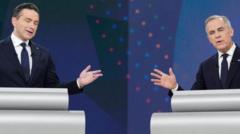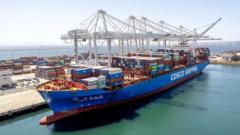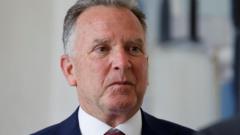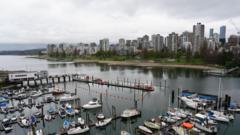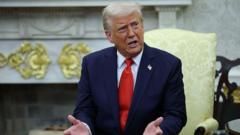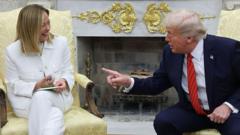In a pivotal French-language debate, leaders of Canada’s four major parties discussed U.S. President Donald Trump’s influence on the election, their responses to a looming trade war, and addressed pressing issues like housing and climate change.
Canada's Political Leaders Confront Trump's Influence in Election Debate

Canada's Political Leaders Confront Trump's Influence in Election Debate
The first debate ahead of Canada’s upcoming election saw party leaders spar over Trump’s impact and key domestic issues.
The leaders of Canada's main political parties faced off in a heated French-language debate in Montreal on Wednesday, tackling the ramifications of U.S. President Donald Trump's influence during the campaign leading up to the April 28 election. The highly anticipated debate provided a platform for Liberal leader and Prime Minister Mark Carney, Conservative leader Pierre Poilievre, Bloc Québécois leader Yves-François Blanchet, and New Democratic Party (NDP) leader Jagmeet Singh to present their strategies and differentiate their views.
Moderated by Radio-Canada journalist Patrice Roy, the debate began with a strong emphasis on Trump's recent actions, including economic threats posed by U.S. tariffs. Roy highlighted the urgency of addressing Canadian domestic issues beyond Trump's shadow, prompting each leader to propose two policy promises disconnecting from U.S. relations. However, the conversation quickly shifted to how each party plans to confront the escalating trade tensions, characterized as the "elephant in the room."
Trump's implementation of steep tariffs on Canadian goods over the past years has raised alarms in the political arena. Poilievre critiqued the Liberal government, asserting that it has left Canada vulnerable to external pressures throughout the last decade. In contrast, Carney underscored his extensive experience in the banking sector, implying that an understanding of international trade dynamics would position Canada favorably.
Singh characterized both Carney and Poilievre as insufficient to protect Canadian jobs from U.S. tariffs, emphasizing that their proposals would predominantly benefit the wealthy. The debate marked a significant moment for Carney, who is leading in pre-election polls but found himself under scrutiny for his weaker French proficiency. He often struggled to articulate his points effectively among the rapid exchanges, eliciting frequent jabs from other candidates, notably Blanchet, who insisted that the political philosophy of the Liberal Party had not changed with Carney's leadership.
Aside from trade discussions, leaders debated how to tackle Canada's ongoing housing crisis and maintain a balance between climate objectives and economic growth. Poilievre pledged to eliminate bureaucratic obstacles that hinder housing construction, while aligning with Carney on increasing oil and gas production. They also resonated with each other in recognizing Canada’s urgent need to enhance its capacity to integrate newcomers amidst a booming population and increasing asylum seekers, partly linked to the restrictive policies of the Trump administration.
Interestingly, the Green Party was absent from the debate, having been disqualified under criteria related to national support and candidate endorsements, prompting criticism from co-leader Jonathan Pedneault who labeled the decision as undemocratic.
The debate concluded with a light-hearted exchange regarding the candidates' consuming habits concerning U.S. products. However, the majority of the discussion underscored the tense political landscape as the candidates prepare for a second, more widely viewed debate in English, before voters head to the polls at the end of April.
Moderated by Radio-Canada journalist Patrice Roy, the debate began with a strong emphasis on Trump's recent actions, including economic threats posed by U.S. tariffs. Roy highlighted the urgency of addressing Canadian domestic issues beyond Trump's shadow, prompting each leader to propose two policy promises disconnecting from U.S. relations. However, the conversation quickly shifted to how each party plans to confront the escalating trade tensions, characterized as the "elephant in the room."
Trump's implementation of steep tariffs on Canadian goods over the past years has raised alarms in the political arena. Poilievre critiqued the Liberal government, asserting that it has left Canada vulnerable to external pressures throughout the last decade. In contrast, Carney underscored his extensive experience in the banking sector, implying that an understanding of international trade dynamics would position Canada favorably.
Singh characterized both Carney and Poilievre as insufficient to protect Canadian jobs from U.S. tariffs, emphasizing that their proposals would predominantly benefit the wealthy. The debate marked a significant moment for Carney, who is leading in pre-election polls but found himself under scrutiny for his weaker French proficiency. He often struggled to articulate his points effectively among the rapid exchanges, eliciting frequent jabs from other candidates, notably Blanchet, who insisted that the political philosophy of the Liberal Party had not changed with Carney's leadership.
Aside from trade discussions, leaders debated how to tackle Canada's ongoing housing crisis and maintain a balance between climate objectives and economic growth. Poilievre pledged to eliminate bureaucratic obstacles that hinder housing construction, while aligning with Carney on increasing oil and gas production. They also resonated with each other in recognizing Canada’s urgent need to enhance its capacity to integrate newcomers amidst a booming population and increasing asylum seekers, partly linked to the restrictive policies of the Trump administration.
Interestingly, the Green Party was absent from the debate, having been disqualified under criteria related to national support and candidate endorsements, prompting criticism from co-leader Jonathan Pedneault who labeled the decision as undemocratic.
The debate concluded with a light-hearted exchange regarding the candidates' consuming habits concerning U.S. products. However, the majority of the discussion underscored the tense political landscape as the candidates prepare for a second, more widely viewed debate in English, before voters head to the polls at the end of April.


